Shogayaki pork is incredibly juicy and tender, infused with a zingy soy and ginger caramelised sauce. Get this amazing Japanese ginger pork on the table in just 20 mins!
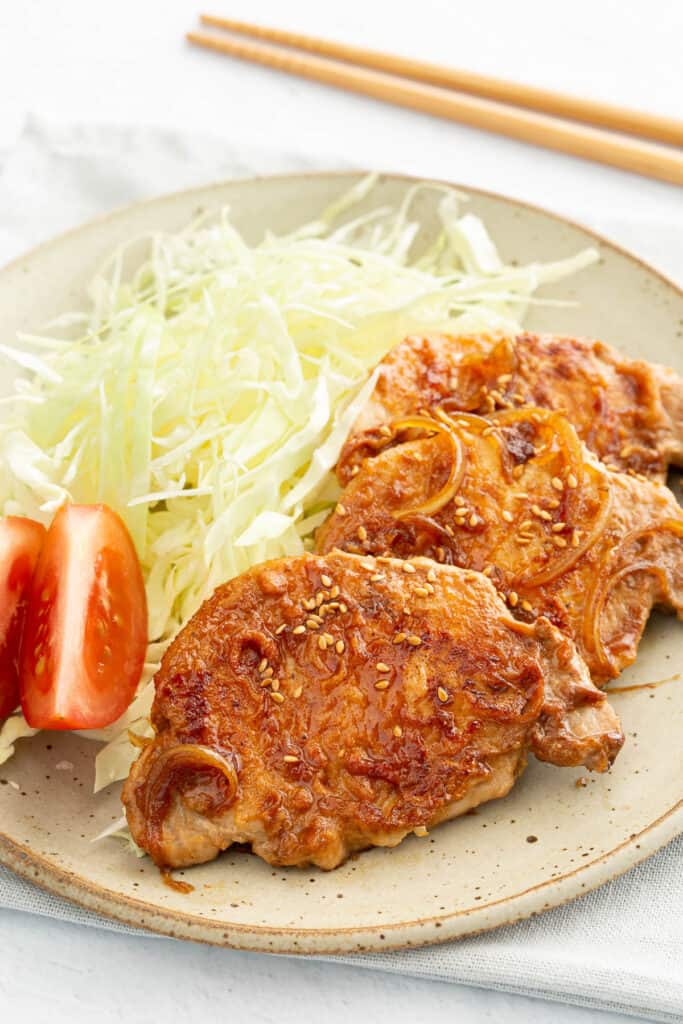
Why We Love This
This easy shogayaki recipe is so full of flavour and cooks amazingly fast – no marinating required.
This homestyle Japanese dish is equally delicious whether you serve it hot as a main or cold in a homemade bento box.
It’s easy to adapt the recipe to suit your flavour preferences. Some Japanese households use sliced or grated onion, some don’t. Some cut it into bite size pieces like a stir fry while others keep them as steaks.
Use our recipe as a guide, but always feel free to experiment and make it your own way!
Related: Vietnamese Ginger Chicken / Korean Chicken Bulgogi
Did you know?
In Japan, shogayaki is traditionally made with a variety of Japanese ginger known as myoga (茗荷). Outside of Japan it’s totally fine to use regular ginger which is more widely available. The flavour is pretty similar between the two types of ginger, except myoga is less pungent and only the shoots and buds are used instead of the roots.
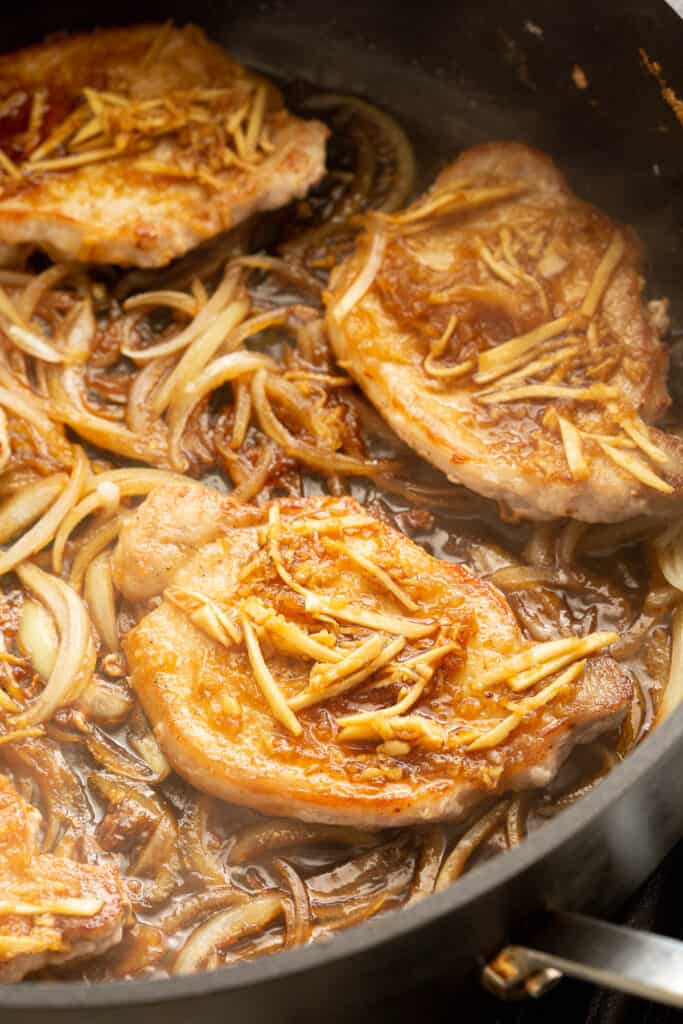
What is Shogayaki?
The full name of today’s recipe is 豚 の 生姜焼き (pronounced buta no shōgayaki). It’s made up of the words:
- buta – 豚 / pork
- shoga – 生姜 / ginger
- yaki – 焼き / to grill or fry
In Japan this dish is usually made with thin slices of pork loin or pork belly, but you can also make shogayaki with beef or chicken if you prefer.
Whichever protein you choose, it’s fried until browned, then braised in a mix of soy sauce, sake, mirin and fresh ginger. Sometimes sliced or grated onion is added for extra flavour and texture.
What You’ll Need
- Pork – Thinly sliced pork loin or belly are traditional, but you can use any cut of pork you like. You may need to adjust the cooking time to suit thicker pieces of meat if you do. If using thin slices of pork belly, skip the flour, as there’s no need to tenderise that type of cut! Sub with beef, chicken or even tofu.
- Flour, Salt & Pepper – The flour helps to coat the pork slices and lock in the juicy texture. Salt and pepper is optional (but delicious!).
- Ginger – We’ll be using grated ginger in the seasoning and finely sliced ginger for texture in every bite. Use Japanese myoga if you can source it.
- Onion (Optional) – Use thinly sliced onion for more texture, or grate some into the seasoning mix for a stronger burst of flavour. Or do both like we did! Totally up to you.
- Soy Sauce – For the best flavour use a Japanese soy sauce such as Kikkoman which has the perfect balance of flavour and salt. Sub with tamari for a gluten-free option.
- Cooking Sake – This helps to remove the gamey taste from meat. Sub with Chinese cooking wine, sherry or a blend of 50:50 vodka and water in a pinch, or just use water if your diet excludes alcohol.
- Mirin – This is a sweet rice wine for cooking which adds glossy shine to the shogayaki sauce. You can sometimes find it in regular supermarkets, otherwise head to your nearest Asian grocer or online. Sub with 1 tsp of sugar if you need.
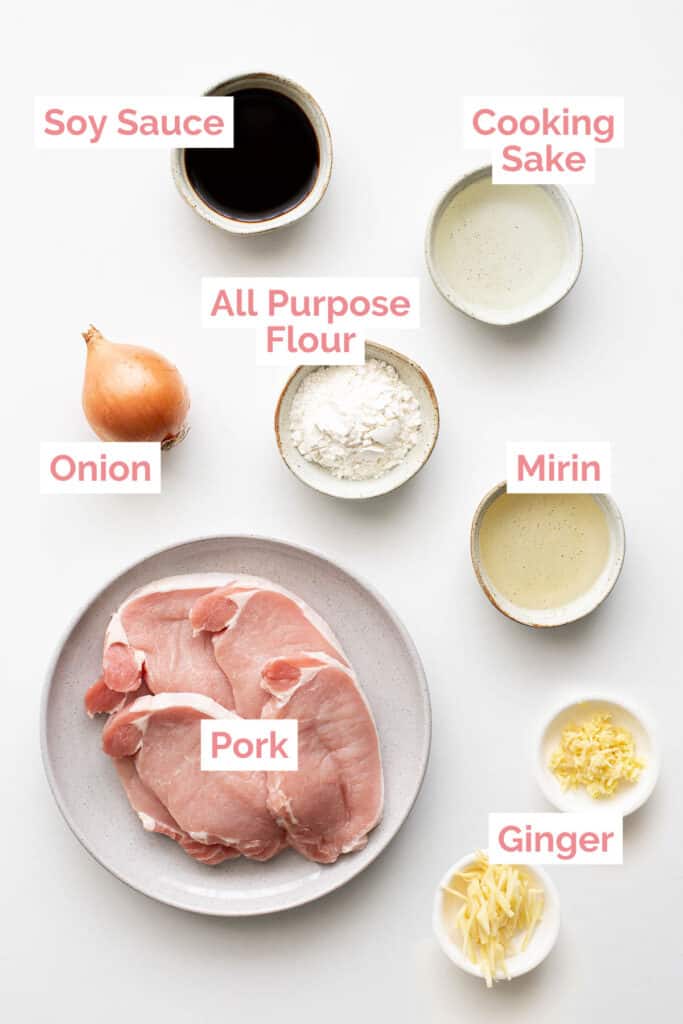
How to make Shogayaki
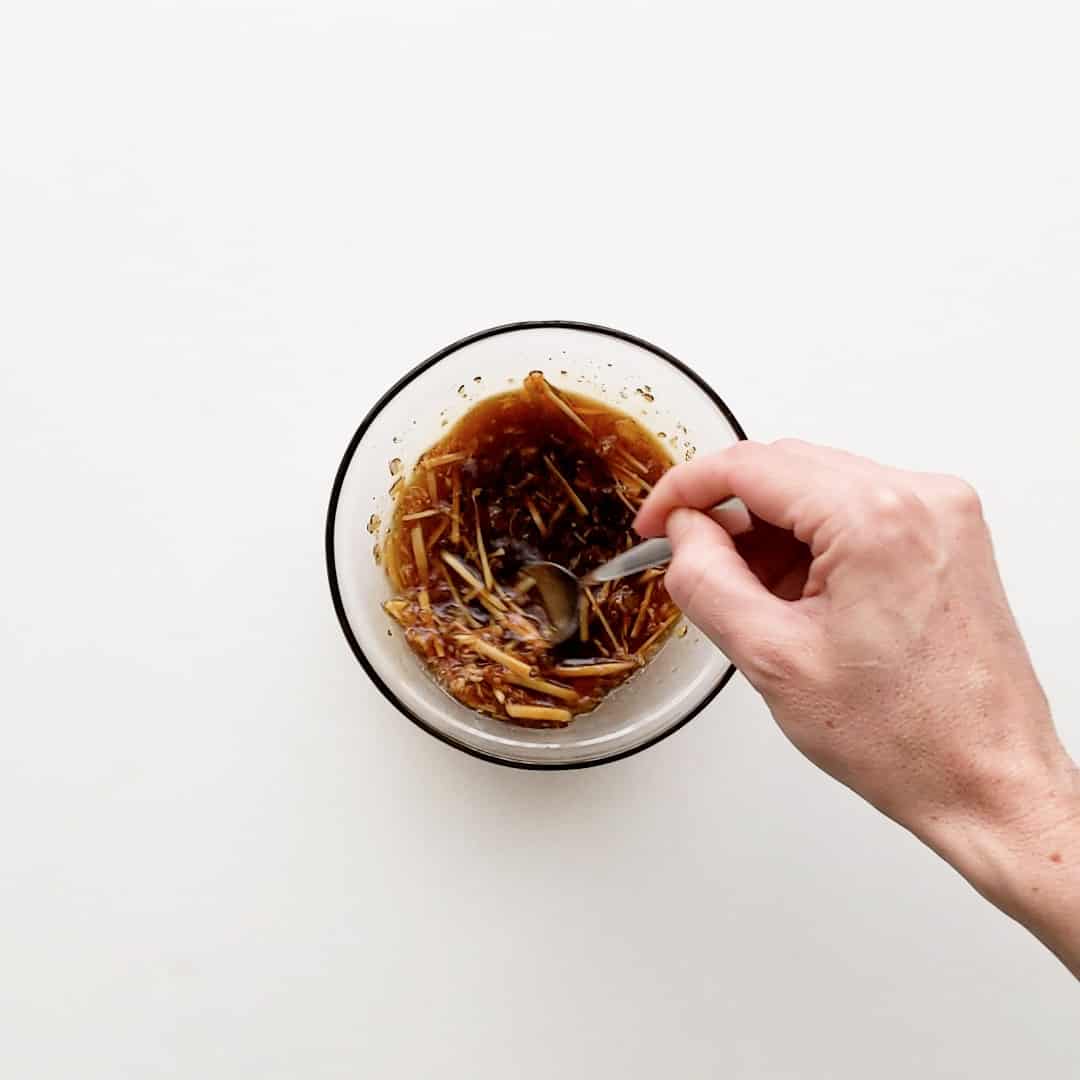
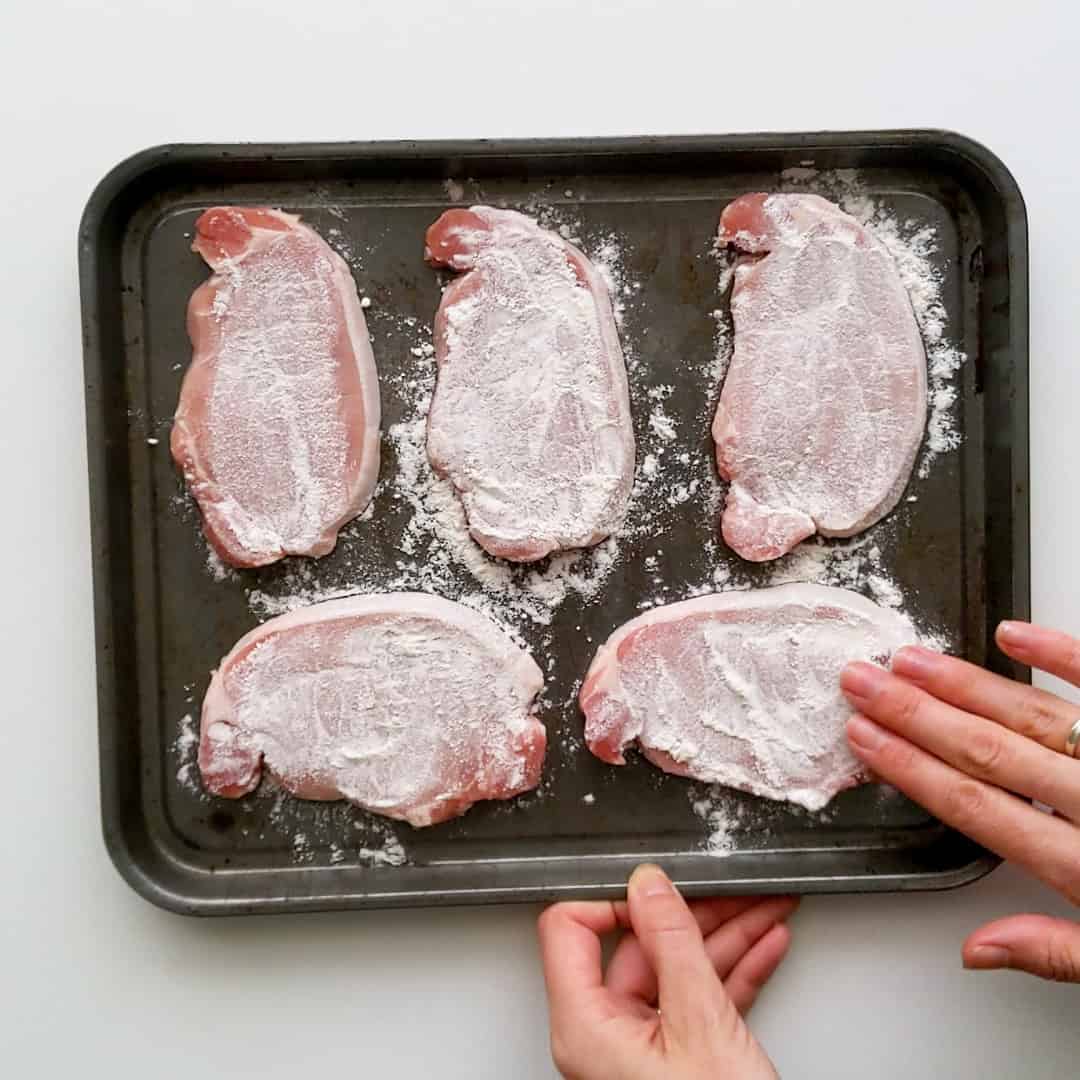
- Mix together the sauce ingredients (grated and julienned ginger, optional grated onion, soy sauce, mirin and sake) in a small bowl until combined.
- Lay the thin pork loin strips on a plate. Sprinkle with flour and season with salt and pepper on both sides, loosely rubbing in the flour to make sure it’s well coated. This will help soften the meat and hold in the juices while cooking.
- Heat a large frying pan over high heat and drizzle in the vegetable oil. Lay in the coated pork loin steaks in the heated pan and fry for around 2-3 minutes on the first side.
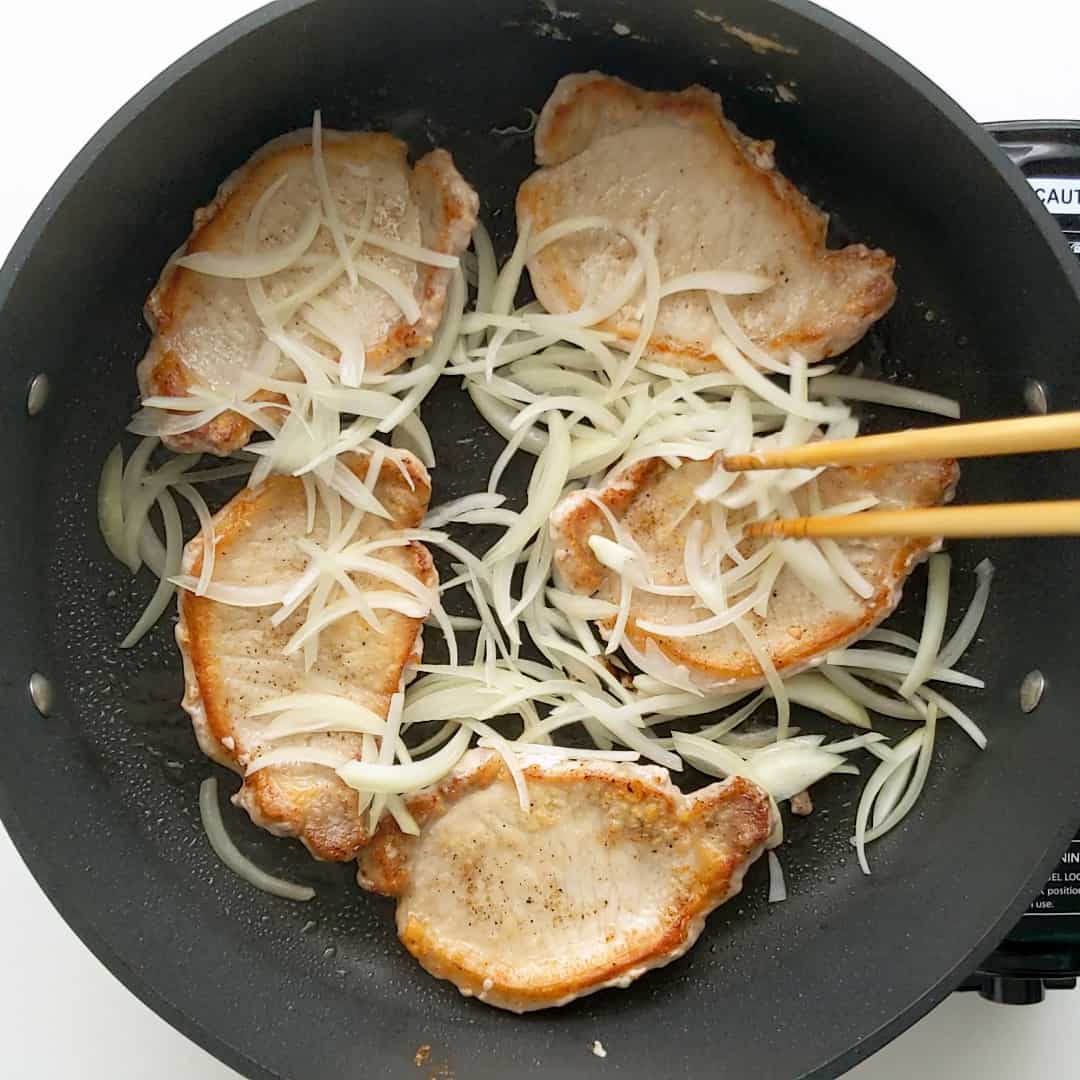
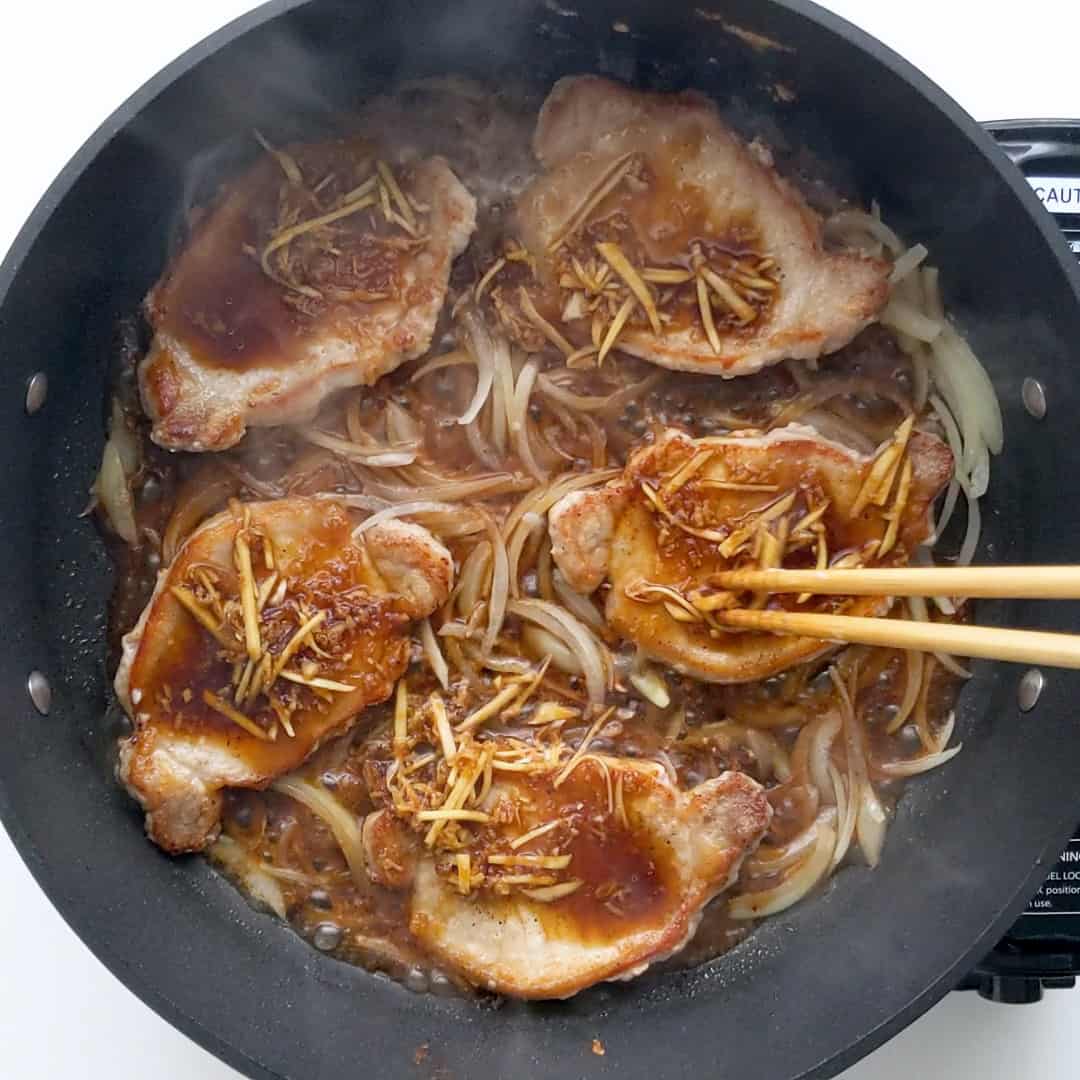
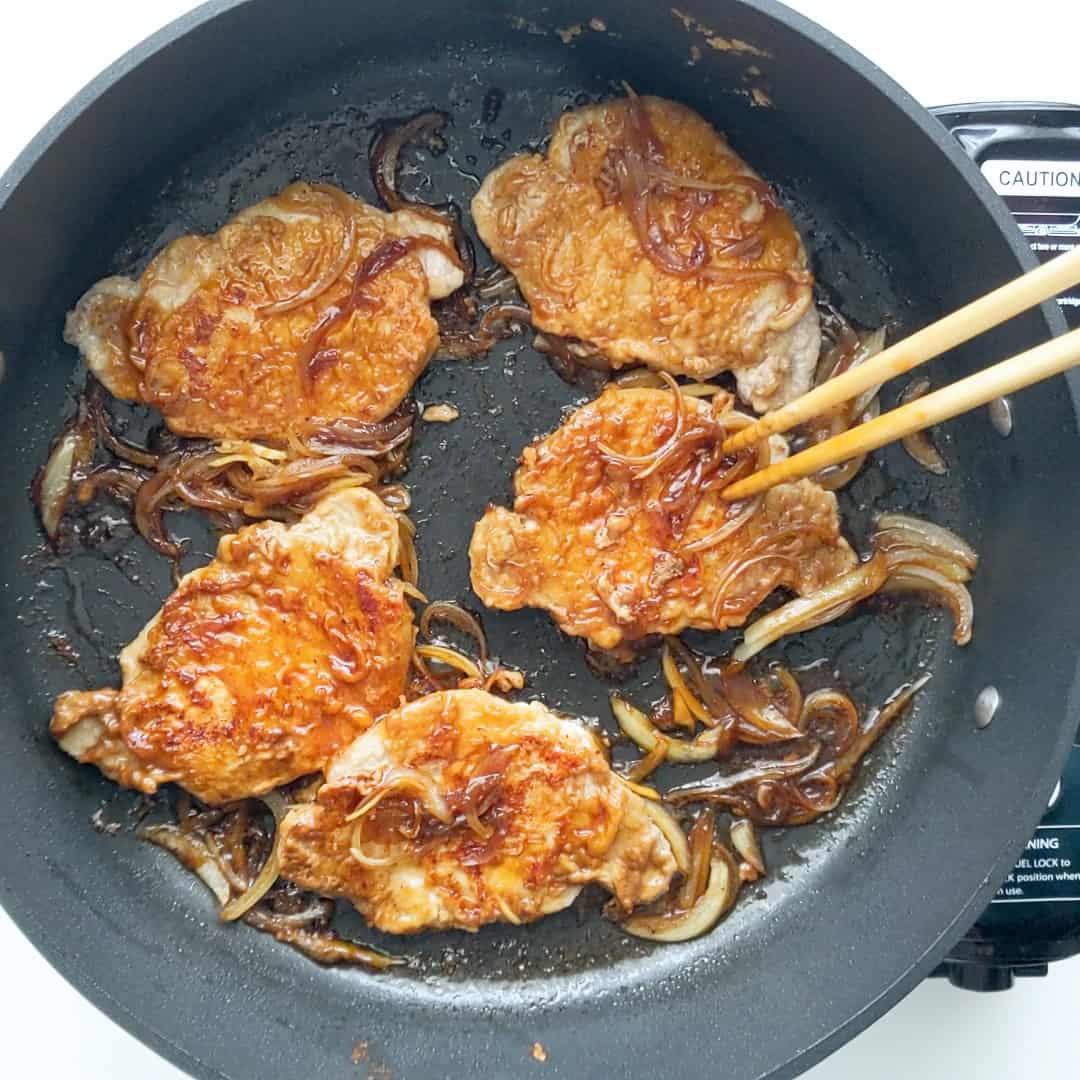
- Flip the pork sliced and add in the sliced onion. Cook for another 2-3 minutes. Pork should be a light golden brown by this point.
- Pour over your seasoning sauce, and allow it to cook down and soak into the pork. Once the sauce has evaporated, switch off the heat. Serve with shredded cabbage (or lettuce), tomato, cucumber, rice and a sprinkle of sesame seeds.
Wandercook’s Tips
- Pork – If your pork slices have a layer of fat around the edges, it’s a good idea to lightly score the connective tissue between the meat and fat every 2 cm / 1 inch with a sharp knife. This helps to stop the slices curling up while cooking, keepign them nice and flat.
- Sauce – You can reduce the sauce just a little, or cook down for longer to make it more caramelised and sticky. If you have leftover cooked ginger sauce in the pan, use this to baste the meat for extra glossy shine, or as a dressing over the salad.
- Storage – Store any leftovers in an airtight container in the fridge for 2-3 days. Reheat in the microwave or in a frying pan over low to medium heat so you don’t burn the sugars in the sauce.
FAQs
Shogayaki and teriyaki are two Japanese dishes that share a similar cooking method. Proteins such as pork or chicken are grilled or fried and braised in a mix of Japanese seasonings that include soy sauce, sake and mirin.
The biggest differences between these two dishes is the choice of protein and the overall flavour. Shogayaki is usually made with pork and ginger, while teriyaki is usually made with chicken and doesn’t usually include ginger.
Shogayaki is amazing served hot with a few simple sides like shredded raw cabbage, steamed rice or wafu salad. You could also serve it with steamed or oven baked broccoli and carrots. Why not add a squiggle of kewpie mayonnaise or a bowl of nourishing miso soup on the side?
Shogayaki can also be served cold, making it a perfect addition to homemade bento boxes alongside takuan pickles, sushi rice, kinpira gobo or a small portion of Japanese potato salad.
No, we don’t recommend it. The flavour and juice from the fresh ginger are essential.
Variations
- Protein – Try this with thin beef steaks, sliced chicken breast or whole boneless, skinless chicken thighs instead. It even works amazingly well with firm tofu steaks for a vegan/vegetarian version!
- More Flavour – Grate garlic and extra onion in with the seasonings.
- Optional Marinade – Rest the pork in a splash of cooking sake and/or ginger juice for 10-20 minutes before cooking. This will help to cover the strong meaty flavour of the pork, perfect if you have any fussy family members.
- Skewers – Try it with diced pork threaded onto skewers, then cook and braise as per the recipe below. Otherwise, you could use the soy and ginger seasonings from this recipe on Japanese chicken skewers or tsukune meatball skewers.
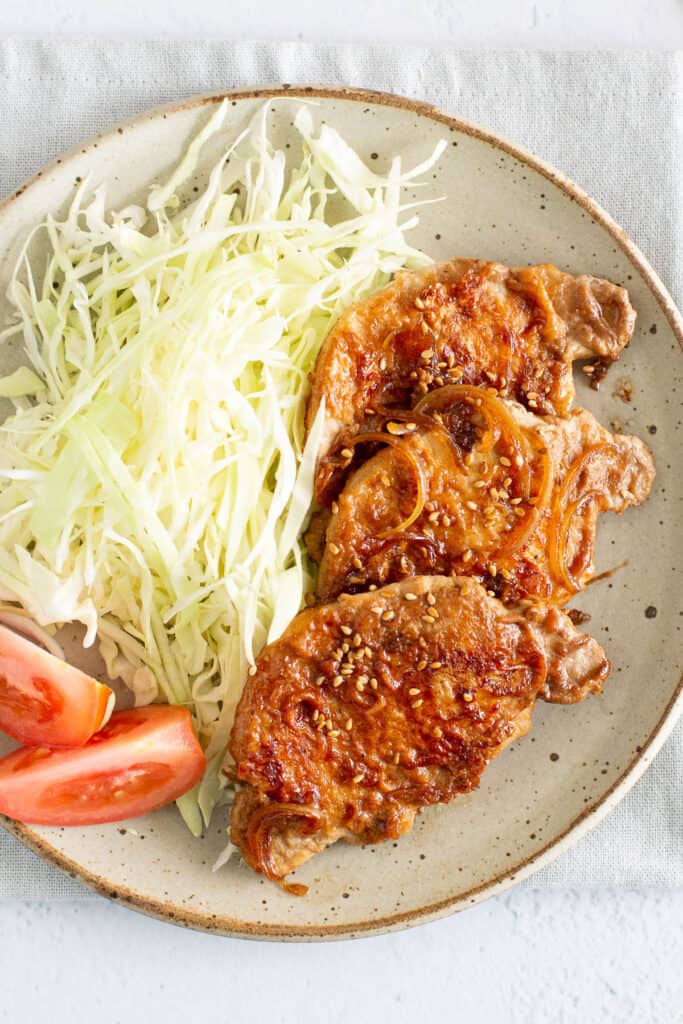
Try these amazing recipes next:
- Yaki Udon – Deliciously chewy Japanese stir fried noodles.
- Nikujaga – Amazing one pot Japanese beef and potato stew.
- Chicken Nanban – Including our incredibly easy homemade tartare sauce.
- Zosui – Cosy and comforting Japanese rice soup.
- Miso Salmon – Juicy, flaky salmon marinated in Japanese seasonings.
★ Did you make this recipe? Please leave a comment and a star rating below!
Equipment
- 1 Large flat-bottomed fry pan, cast iron fry pan, or portable electric cooker
Ingredients
- 300 g pork loin sliced into thin steaks, can also use thin pork belly pieces and skip the flour
- 2 tbsp plain flour / all purpose flour sub with potato starch or cornstarch
- ½ onion sliced into thin half moons
- 1 tbsp vegetable oil sub with sesame oil for more flavour
- Salt and pepper to taste
For the sauce
Optional serving ideas
- cabbage shredded, sub with lettuce
- tomato a few slices
- cucumber a few slices
- rice
- sesame seeds toasted or raw
Instructions
- Mix together the sauce ingredients (grated and julienned ginger, optional grated onion, soy sauce, mirin and sake) in a small dish until combined.2 tbsp ginger, 1 tbsp ginger, ½ onion, 2 tbsp soy sauce, 2 tbsp mirin, 2 tbsp cooking sake
- Lay the thin pork loin strips on a plate. Sprinkle with flour and season with salt and pepper on both sides, loosely rubbing in the flour to make sure it’s well coated. This will help soften the meat and hold in the juices while cooking.300 g pork loin, 2 tbsp plain flour / all purpose flour, Salt and pepper
- Heat a large frying pan over high heat and drizzle in the vegetable oil.1 tbsp vegetable oil
- Once hot, lay in the coated pork loin steaks and fry for around 2-3 minutes on the first side, then flip and add in the sliced onion around to cook alongside the pork for another 2-3 minutes. Pork should be a light golden brown by this point.½ onion
- Pour over your seasoning sauce, and allow it to cook down and soak into the pork. Once the sauce has evaporated, switch off the heat.
- Serve hot with your choice of garnishes: shredded cabbage (or lettuce), tomato, cucumber, rice and a sprinkle of sesame seeds.cabbage, tomato, cucumber, rice, sesame seeds
Video
Recipe Notes
- Sauce – You can reduce the sauce just a little, or cook down for longer to make it more caramelised and sticky. If you have leftover cooked ginger sauce in the pan, use this to garnish the meat or as a dressing over the salad.
- Storage – Store any leftovers in an airtight container in the fridge for 2-3 days. Reheat in the microwave or back in the frying pan over low to medium heat so you don’t burn the sugars in the sauce.
- Protein – Try this with thin beef steaks, sliced chicken breast or whole boneless, skinless chicken thighs instead. It even works amazingly well with firm tofu steaks for a vegan/vegetarian version!
- More Flavour – Grate garlic and extra onion in with the seasonings.
- Optional Marinade – Rest the pork in a splash of cooking sake and/or ginger juice for 10-20 minutes before cooking. This will help to cover the strong meaty flavour of the pork, perfect if you have any fussy family members.
- Skewers – Try it with diced pork threaded onto skewers, then cook and braise as per the recipe below. Otherwise, you could use the soy and ginger seasonings from this recipe on Japanese chicken skewers or tsukune meatball skewers.
Nutrition
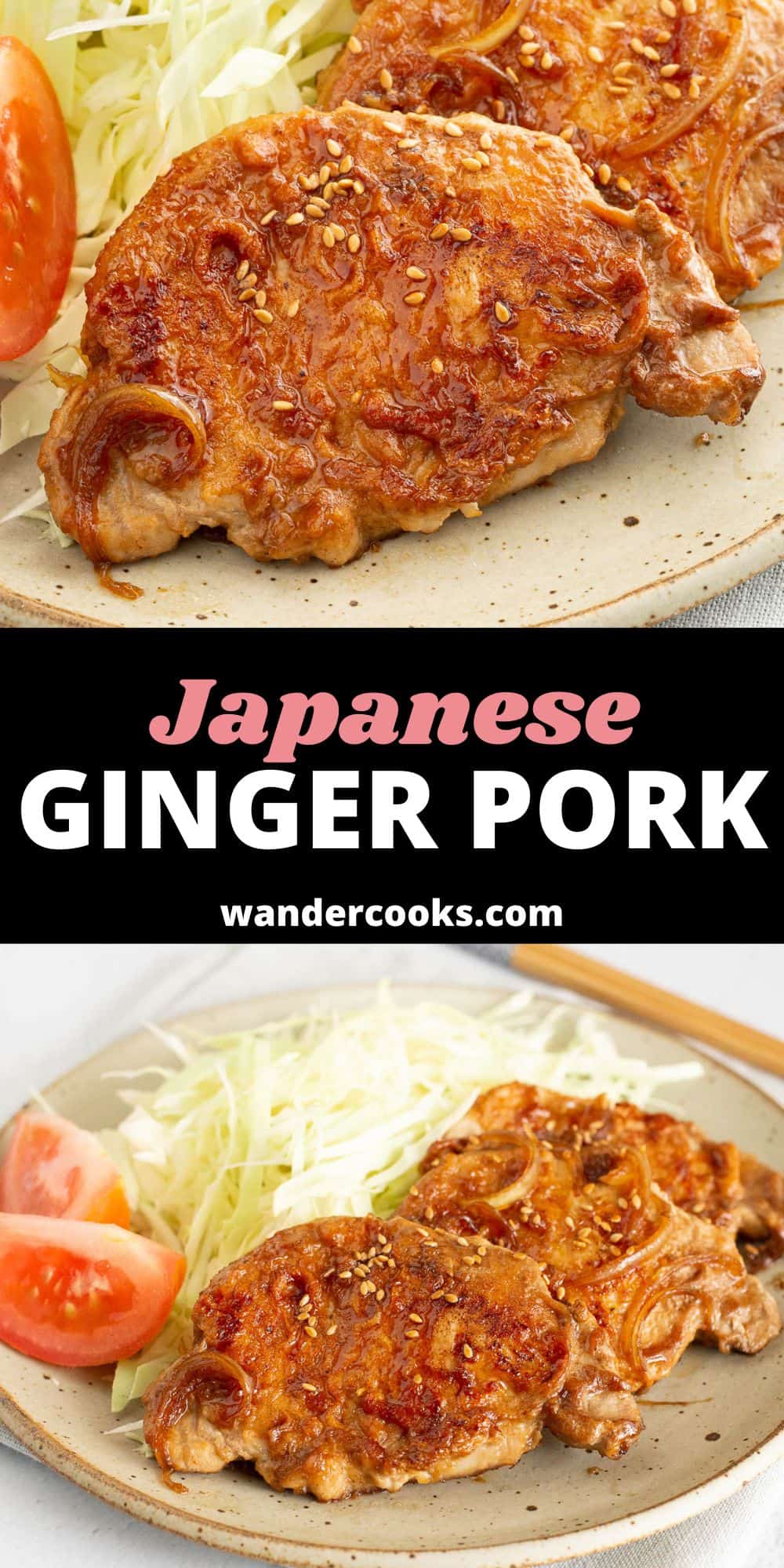

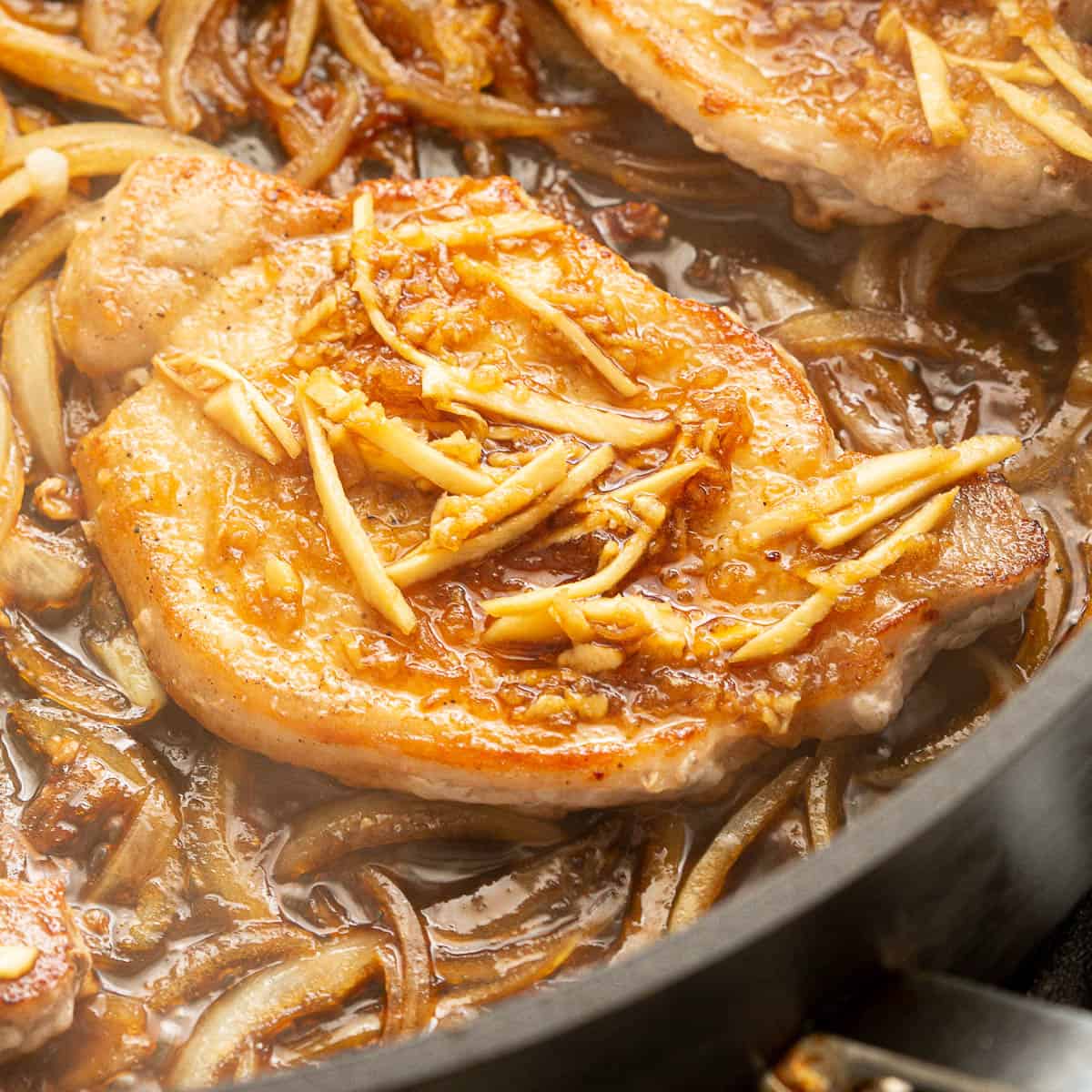



2 Comments
Frida
22/09/2022 at 10:38 amI made it but with chicken. So yummy…. Thx for your recipes, it helps me to cook
Wandercooks
22/09/2022 at 12:28 pmGreat swap with the chicken, and you’re very welcome. So glad it helps you to cook!